Slowing your lure retrieve down is so simple, yet so effective. This certainly isn’t a new topic, yet it makes such a supreme difference to your catch rate that I thought I might reinvent the wheel, so to speak.
These days you see so many anglers who can thread a needle with a lure and are extremely adept at getting deep into the strike zone of a snag, only to wind the lure straight back out again. It breaks my heart.
I remember being a young angler, with my very first baitcaster, working a bank of the Mulgrave River. I was fishing with my father and a friend of his, Dave ‘Lumpy’ Milson, a well known angler from the region. I was full of youthful pluck and exuberance and I was literally thrashing the water to foam, yet time and time again the fish fell to my more experienced companions.
Exasperated, after watching Dad and Dave pull a pair of feisty barra from deep below a bushy overhang, I asked for some advice. I think my boyish impatience was wearing thin by this stage, so all I received were two firmly spoken words: “slow down”.
The tone of the advice offered no room for reply, so with the air blown clean out of my sails, I became mildly sullen and dejected. My zeal failed to return as the day wore on, but late in the afternoon, everything changed.
I put in a long, looping cast that landed with a splash on the very edge on some exposed rock. Rather than retrieve the lure, I turned around to boast about my miraculous cast. I had just delivered a less than modest description of my (fluked) cast when suddenly my arm was yanked backwards in its socket and I was pulled around like a ragdoll on a clothesline.
Turning around, revealed a dark shape charging for the nearby rocks and a hole in the surface of the water that was truly impressive. I fought hard to turn the fish’s head and ended up grinning from ear to ear as Dave netted a thumping great sooty for me. It scraped the 50cm mark and remains my PB for this species. The revelation that hit me though, wasn’t the size of the fish; it was the fact that it took a still lure. In fact, the lure had been sitting completely motionless for almost ten seconds. From that day on my lures stayed in the strike zone for as long as possible.
On another occasion, I remember being in the thick of the timber on Teemburra Dam. My Dad, Graham, was netting a barra for me only to have his new G Loomis rod buck alarmingly from the floor of the boat. He lunged for it and caught it, as a 70cm fish leapt into the air beside the boat with his lure in its mouth. The fish had snatched the floating lure from its resting place beside the boat.
Ever since, I’m convinced that you simply can’t work a lure slow enough. In fact, because of these two incidents, I now pause, twitch and float my lures and I’ve learnt how to make them back up. Not only has my strike rate improved, but the visual aspect of this kind of fishing has me hooked for life! It really did teach me the golden rule – if in doubt, slow down!
A strike zone is any place that makes your fishing senses tingle; be it the gap between two trees, the mouth of a gulley or a nook in the lily pads. It’s one of those prime predatory ambush points that all good fishermen can recognise instantly.
Once you’ve located one of these hotspots it becomes a matter of putting in that essential cast. Aim for the deepest part of the structure, especially during periods of low water temperature or strong sunlight, as many predatory species like barra can be incredibly lazy. Some days they will sit well back under structure until you literally hit them on the nose or annoy them into striking by twitching a lure right in their face for a long period of time. Also, be prepared to work these likely spots with more than a few glancing casts because it’s common for a barra to be incredibly fussy.
Try working a strike zone over with a variety of lures and even experiment with different stages of the tide or times of day. Don’t take your eyes off your lure because with a good pair of polarized sunglasses you can pick up a flash or swirl that betrays the presence of a predatory fish.
Yes, stop. Don’t be in a hurry to retrieve your lure the instant it touches the surface. Remember, barra have eyes on the top of their head for a reason. They love swatting prey from the surface, be it a bug, a baby bird, a lizard or a lure, so make the most of the lure’s initial impact.
Leave it and watch the water underneath as you give it the odd twitch (use the rod tip only and refrain from breaching the surface at this stage). Be aware that this is a technique that works exceptionally well with surface lures (like poppers) as well. You’d be amazed how often, doing so little, can provoke a powerful surface strike that results in a watery boof and the screaming of a drag.
From this point, be creative. I like to twitch bibbed lures down and then let them float back up. If you do this right you can actually get the lure to return to almost the same spot over and over; this is ideal for milking a strike from a sleepy barra.
Good lures for this type of work should have rounded bibs that lead the lure into structure (thus keeping the hooks away from snags) and should float slowly or have neutral buoyancy. Be aware though, really thick snag piles call for more buoyancy, as it becomes difficult to work a suspending lure over continual submerged branches.
This is completely necessary as different structure, naturally calls for different lures. For instance a narrow suspending lure (like a Rapala X-Rap) is ideally suited to working the drop off where a gulley intersects a creek bed because you can dig it down to the strike zone and hold that position.
Alternatively, a small buoyant lure like a Reidy’s Little Lucifer is better suited to ‘walking’ through a bushy, submerged lantana patch. It is also worth casting a selection of lures at a strike zone, because every lure behaves differently and resembles a different bait type. If in doubt, try to match the bait in the local area as closely as possible.
Hopefully I haven’t gone over ancient ground here too much, but fast retrieval speed remains one of the simplest mistakes made by anglers in all areas of lure fishing. Don’t get me wrong, there is a time and a place for the fast retrieve or the rapidly ‘burnt’ lure that vibrates past a strike zone for the ‘reaction bite’, but if the fish aren’t biting their heads off, the chances are that you’ll need to milk that strike. If you can hit the strike zone and leave your lure there for the maximum time, while making your lure look as appetising as possible, you’re in with half a chance. Those extra few seconds make all the difference.
Until next month, fish hard, stay safe and I’ll hopefully catch you on the water somewhere.
Facts
Author’s Top 5 Lures
Reidy’s Little Lucifer
Killalure Flats Ratz 10+
Reidy’s Little B52
10cm Rapala X-Rap shallow
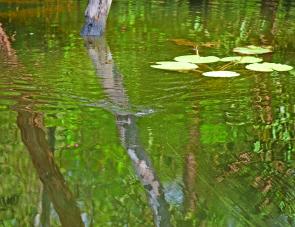
Always take your time around prime structure.
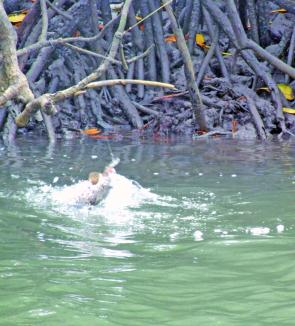
A cod smashes a motionless lure that is looped over a stick.

A cod smashes a motionless lure that is looped over a stick.
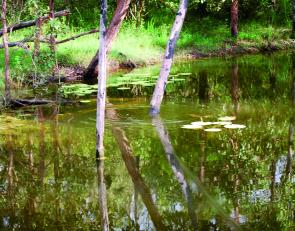
Once your lure is in a key ambush point like the one in this picture don't be in a hurry to wind it out!
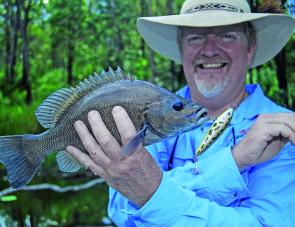
Surface lures work better when worked slowly especially in the freshwater.

The rewards for a well presented lure are great.
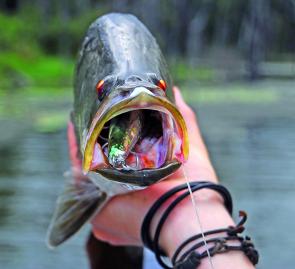
What happens when you pause at exactly the right time!




